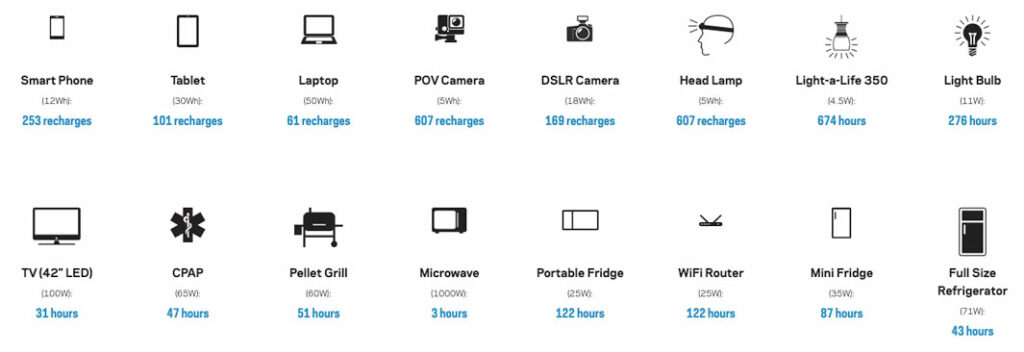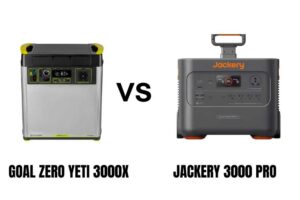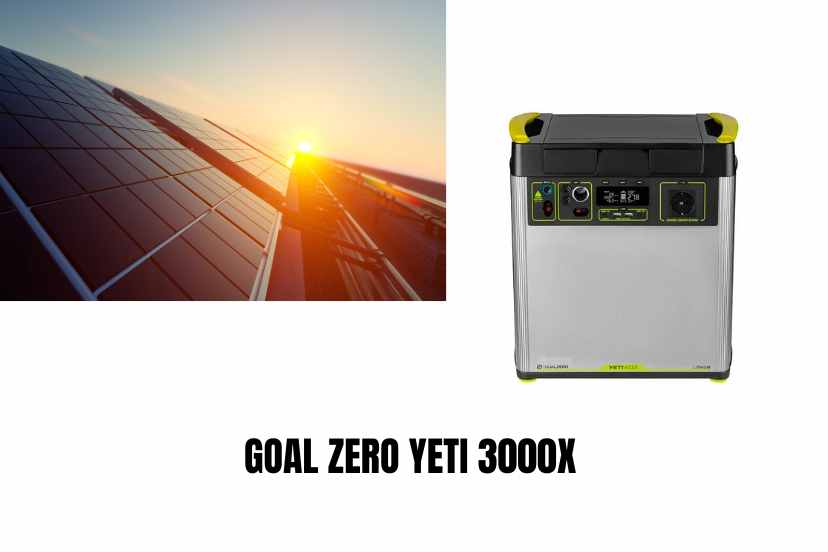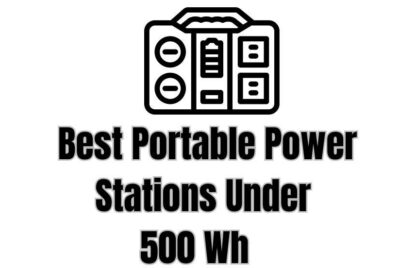Goal Zero Yeti 3000X – Can It Power Your Lifestyle?
I may earn a commission for purchases made through my links. It helps me run this site. Check out my disclosure for more details.
The Goal Zero Yeti 3000X is a well established power station. It’s the half sized sibling of the Yeti 6000X, which naturally has twice the watt-hour capacity. 6071Wh of power can be a bit daunting for some people. 3000Wh is enough to power some heavy demand tools and household appliances. Just look at these run times, for the Goal Zero Yeti 3000X to see what it can run.
| Device | Goal Zero Yeti 3000X Run Times |
|---|---|
| Smart Phone | 253 recharges |
| Tablet | 101 recharges |
| Laptop | 61 recharges |
| POV Camera | 607 recharges |
| DSLR Camera | 169 recharges |
| Head Lamp | 607 recharges |
| Light-a-Life 350 Lamp | 674 hours |
| Light Bulb | 276 hours |
| TV (42″ LED) | 31 hours |
| CPAP | 47 hours |
| Pellet Grill | 51 hours |
| Microwave | 3 hours |
| Portable Fridge | 122 hours |
| WiFi Router | 122 hours |
| Mini Fridge | 87 hours |
| Full Size 300 Watt Refrigerator | 10 hours |
For small devices, this machine is a killer, but it can even tackle those larger appliances. But what are the recharge times like?
| Feature | Goal Zero Yeti 3000X |
|---|---|
| Battery Capacity | 3032 watt-hours |
| Inverter | 2000W continuous output, 3500W surge capability |
| Battery LifeSpan | 500 cycles to 80% |
| Charging time | With supplied 230W Charger: 14 hours With optional 600W Charger: 6 Hours Solar Charging with 1 x 200w Boulder Briefcase Solar Panel: 18-36 Hours |
| Weight | 69.78 pounds |
| Portability | Supplied With Roll Cart |
| AC output | 120V, 60Hz, pure sine wave |
| DC output | 12V, 10A carport, 12V, 30A Anderson Power Pole |
| USB output | 4 USB ports, 5V, up to 2.4A per port, 60 Watt USB-C PD 5- 20V, up to 3.0A, 18 Watt USB-C 5- 12V up to 3.0A |
| Output connections | 2 AC outlets, 2 USB-C ports, 2 USB-A ports, 1 12V carport, 1 12V 30A Anderson Power Pole 360W Max, 6mm 12V port 10A 120W max |
Yeti 3000X Battery Ballistics
Battery life will decrease to 80% after 500 recharges. So if you use your power station twice per week— that is, you recharge it twice per week you may not feel the effect of the reduced battery for 4 years. The battery will still work, but it will lose about 20% of its storage capacity. If you charge yours all the time and even use pass through charging so you are recharging it as you use it, nearly every day, then you could notice the drop in the battery in as little as two years. This is one of the major drawbacks of the 3000X. It also continues on Goal Zero’s flagship product, the 6000X. It’s a shame, as these are premium priced power stations.
Part of the reason is the battery chemistry, and Goal Zero is also using 12 volt batteries in their power stations. As they need to output 120V of electricity when you plug appliances into the AC Outlet, the battery has to work super hard. You are talking about a 10 fold increase in power conversion, so naturally the battery is going to take quite a beating over the long term. If Goal Zero had used a 48V or even a 24V battery, it wouldn’t have to work under so much pressure.
Yeti 3000X Home Integration & Expansion
If you are happy with the number of output ports the 3000X offers but just want to increase the battery capacity, you can greatly expand this system. Expansion kits, or tanks, as Goal Zero calls them, come in these sizes:
- 1.2 kWh
- 2.4 kWh
- 4.8 kWh
It costs roughly the same to buy the Yeti 3000X with the 4.8 kWh expansion tank (and required expansion module connection) as it does to buy the Yeti 6000X, plus you will have an extra 1753 watt-hours (7832Wh total) of battery capacity. One reason people will opt for the 6000X if they need more power than the 3024 watt-hours provided on the 3000X, is that they have everything in one box. So if you want to take everything with you, it’s more portable. Well, if you consider 106 pounds portable for the 6000X, It does cut down on storage space, though.

Goal Zero Yeti 3000X Solar Showdown
One of the main reasons people buy a portable power station, even such a large beast as the 3000X, is the ability to regenerate the power with solar panels. But the solar charging offered by Goal Zero in this power station is limited, which is a bit of a letdown. It all comes down to the maximum solar input you can load through the MPPT charge controller, which regulates the electrical charge from the solar panels running to the power station’s battery. The MPPT controller maintains the battery’s health and stops it from being overcharged.
The maximum solar input is limited to 600W, which means the solar panels can generate 600 watt-hours per hour. That’s why it takes over 5 hours to charge the 3000X to full power. Well, 5 and a half hours is not the longest time in the world, but if you are comparing like for like, the Jackery 3000 PRO solar generator can be charged in just under 3 hours, and that’s also a 3024 Wh power station.
But the problem is not that it takes, say 5.5 hours to charge up the 3000X, that is, if you can get it charged in peak sunshine. So if the sun coverage is not optimal and you are also using the power station, there is no way you will get it fully charged at the end of the day if it is also oozing power if you are running your grill, and higher energy-consuming devices like coffee machines and microwaves, or maybe continuously running a refrigerator all day.
You can do the math and work out how many watt hours appliances will use during the day, so if you are going to use solar to its full potential, you’ll have to cut back on plugging in some appliances if you want a full battery recharge, which isn’t going to be possible. So take a look at these devices and how many watt hours they consume a day, and you’ll get the picture.
- microwave : 1000–2000 Watts per hour
- coffee machine: 600–1200 Watts per hour
- refrigerator: 350–750 Watts per hour
- TV: 50–200 Watts per hour
- blender: 300–1000 Watts per hour
- washing machine: 500–1000 Watts per hour
- chest freezer: 600 Watts per hour
- electric heater: 750–1500 Watts per hour
- vacuum cleaner: 300–1500 Watts per hour
- toaster oven: 1200 Watts per hour
- hot plate: 750 Watts per hour
- clothes iron: 1000–1500 Watts per hour
- Air Conditioning unit (7000–10,000 BTU): 1000–1500 Watts per hour
- laptop: 30-65 Watts per hour
- iPad: 10–20 Watts per hour
The Logistics Of Solar Charging The 3000X to Full Capacity
So going by the above watts per hour consumptions, running an air con unit could effectively eat 1000–1500 watts per hour, but even if you were to run something less power consuming like a fridge for 10 hours, well keeping the battery charged would be impossible in 5.5 hours. As a fridge would use on average 350–500 watts per hour, it wouldn’t take long to totally drain the Yetis battery, in about 6–10 hours or faster depending on the wattage, so you will never get the unit charged back up in a single day.
It’s all good if you don’t mind the battery going totally flat and you just want to go full hog for a day or two. Especially if you are running mini fridges and will be running a few cups of coffee and using your electric grill for 30 minutes to an hour per day. Effectively, you can keep going for days, and with the available sunlight and pass-through charging (charging the unit while you run devices and appliances into it at the same time), If you have access to AC on a camp site, or at home, you will be able to recharge the battery if you have the 600W power supply in 6 hours.
Yeti 3000X vs Yeti 6000X

Here’s a side-by-side comparison table showing these two siblings stats.
| Feature | Yeti 3000X | Yeti 6000X |
|---|---|---|
| Battery Capacity | 3032 watt-hours | 6071 watt-hours |
| Inverter | 2000W continuous output, 3500W surge capability | 2000W continuous output, 3500W surge capability |
| Battery LifeSpan | 500 cycles to 80% | 500 cycles to 80% |
| Charging time | With supplied 230W Charger: 14 hours With optional 600W Charger: 6 Hours Solar Charging with 1 x 200w Boulder Briefcase Solar Panel: 18–36 Hours | With 600W Power Supply: 12 hours Solar Charging : 18–36 hours with 2 X Boulder Briefcase or Nomad 200W solar panels |
| Weight | 69.78 pounds | 106 pounds |
| Dimensions | 15.25 x 10.23 x 13.6 inches | 15.25 x 10.23 x 17.01 in |
| Portability | Supplied With Roll Cart | Supplied With Roll Cart |
| AC output | 2 X 120V, 60Hz, pure sine wave | 2 X 120V, 60Hz, pure sine wave |
| DC output | 12V, 10A carport, 12V, 30A Anderson Power Pole | 12V, 10A carport, 12V, 30A Anderson Power Pole |
| USB output | 4 USB ports, 5V, up to 2.4A per port, 60 Watt USB-C PD 5- 20V, up to 3.0A, 18 Watt USB-C 5- 12V up to 3.0A | 4 USB ports, 5V, up to 2.4A per port, 60 Watt USB-C PD 5- 20V, up to 3.0A, 18 Watt USB-C 5- 12V up to 3.0A |
| Output connections | 2 X AC outlets, 2 X USB-C ports, 2 X USB-A ports, 1 12V carport 160W Max 13A, 1 12V Anderson Power Pole, 6mm 12V port 10A 120W max | 2 X AC outlets, 2 X USB-C ports, 2 X USB-A ports, 1 12V carport 160W Max 13A, 1 12V Anderson Power Pole, 6mm 12V port 10A 120W max |
Final Thoughts on the Yeti 3000X
The Yeti has a whack of power. Not everyone needs a 6071Wh power station. 3032Wh, which is offered here on the Yeti 3000X, is enough even for hardcore needs. The 3000X has been around now for a long time, but that is the problem. It needs an update. For sure, it can expand, which is a very useful feature for home grid integrators. But the battery needs to be retuned. It needs to move to a LifeP04 format so that it charges quicker and also lasts longer.
One thing is for sure: this power station has received a lot of praise and will most likely continue to do so in the months and years ahead. It has lots of fans for it’s impressive power output and industrial-modern design. But there are other power stations that provide this much power, with faster recharge times, better warranties, and the deal breaker for me, a much, much longer battery life, like the Ecoflow Delta Pro with a 3500 battery life cycles and that allows for 1600W of solar input compared to the Yeti’s 600W. The Jackery 3000X also has blazingly fast recharge times and a 3500 battery life cycle.
Goal Zero needs to watch out, they have stiff competition, and rightly so. This market is expensive, and the consumer will move to whoever offers the best value, combined with a good track record. Goal Zero may be the biggest supplier of battery energy in the world, but they need to address battery efficacy and lifespan on their power stations quickly.




